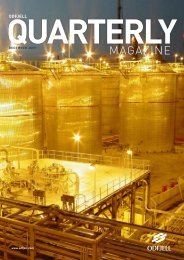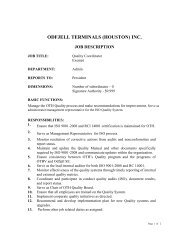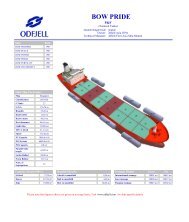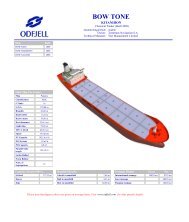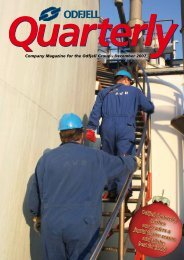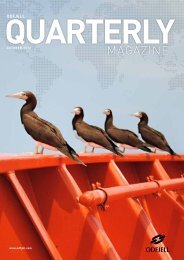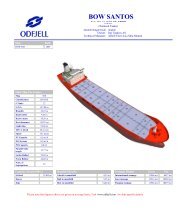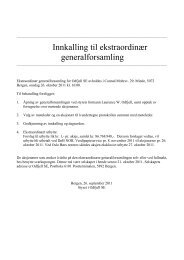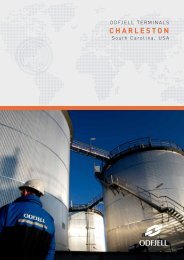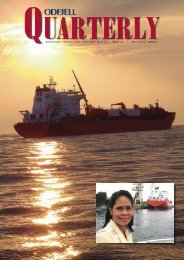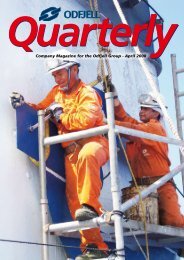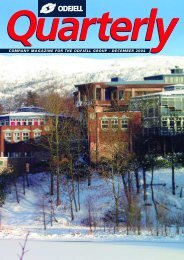Create successful ePaper yourself
Turn your PDF publications into a flip-book with our unique Google optimized e-Paper software.
Navigare necesse est...Celestial Navigation in pre-satellite timesBy Frode BjørklundPositioning is hardlyon people’s mindswhen movingaround. Transportationinfrastructureand moderntechnology havemade it possible todetermine our geographicalpositionanywhere down to a 10 metre radius.Satellite navigation like GPS is everywhere,on board ships, in cars, on handheldreceivers and even PDAs - all combinedwith map software. Then imaginea time where your location might havebeen a most uncertain aspect in life. Letus take a look at how navigation andpositioning was done before the electronics,in an age of great discoveriesand achievements.Let’s start with clearing up a commonmisunderstanding. The heading quoteis often used to stress the importanceof navigation, as in opposite to justdrifting around. The full expression,however, “Navigare necesse est, viverenon est necesse” - To sail is necessary,to live is not necessary- is attributed byPlutarch to Gnaeus Pompeius (Romanpolitician and general first century BC)who, during a severe storm, commandedsailors to bring food from Africa toRome. This highlights how importantwaterborne trade is to society (evenBC). Seafaring in some scale is howevernot possible without proper methodsof navigation, so it is in a sense all connected.10 ODFJELL Quarterly October 2005When man made the first vessels, theseaworthiness was so poor and navigationby recognition was a sufficientmethod of finding the way. When craftsbecame good enough to cross openstretches of water, the brave sailor hadto depend on sound, smell and observationsof waves, birds etc to find back tothe shore. About 2000 BC, the most advancedcivilisations had a good grasp ofthe movements of celestial objects, thesun, moon, planets and stars. The Creteshad, somehow, already crossed theMed safely for a thousand years and thePolynesians used stars and wave direction/patternsto navigate in the Pacificabout 1000 BC.Still, 2,500 years later Columbus reallyhad little clue about his position on hisdiscovering journeys, despite that a lotof ground was made in the meantimein the fields of mathematics, astronomyand the making of instruments andmaps. When Columbus sailed out on hisfamous journey to find the “westernsea-route to India”, he had a compassbut not a sextant. He knew the methodand could with a cross-staff, quadrantor an astrolabe, simple instruments toSanta Maria, Columbus’ flag shipmeasure angles, roughly estimate hislatitude, but not the longitude. As ithappens, he didn’t manage to get hislatitude correctly either. In fact, when atCuba in 1492 at about lat. 20 degreesColumbus thought he was around lat.40 degrees, which corresponds to NewYork.The prevailing method of navigationat that time is known as Dead Reckoning.Course and speed are measured orestimated and plotted on map. We canimagine the errors accumulated whensailing for weeks on the high seas. DuringMagellan’s circumnavigation (1519-1522) the explorer spent a lot of effortto establish longitude whilst the latitudewas under better control. It was actually40 years after Columbus’ last voyagewhen Copernicus in 1539 published hisconclusion that the earth is orbiting thesun and not the opposite, a discoverythat the Catholic Church and the HolyInquisition did their utmost to suppress.It should go another 300 years, around1850, before a fairly accurate positioncould be established just by the meansof observing celestial objects, objectsThe cross staffin the sky, and thus really contribute toocean navigation.What did such positioning require?Firstly, accurate timekeeping wasessential. This was achieved about 1760when the self-taught watchmaker JohnHarrison made a marine chronometerproved to suffice. The importance ofthis achievement is highlighted by thefact that he eventually was grantedthe UK Parliament’s substantial reward“for such person or persons as shalldiscover the Longitude.” Correct timewas necessary to find in nauticalalmanacs the position of celestialobjects at the time of observation. Themaking of such almanacs and tableswas again depending on past observationsand the methods and mathematicsto predict the future movements.Methods and mathematics also had tobe mastered to do on site calculations.Finally, to measure height of objects, anaccurate instrument, as the sextant, wasneeded and of course the skills to use itproperly.So which celestial objects were used?The easiest to observe are the stars.They are so far away and will havethe same position relative to the earththroughout the year. The Polar Starfor example has been an ancient (andperfect) helper in determining latitudeon the northern hemisphere as it isnearly fixed in the sky.Next is the sun. Observing it, one must,due to its closeness, take into accountthe tilting of the earth axis. Accordingly,even when measuring the sun’s height



